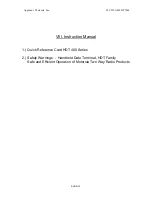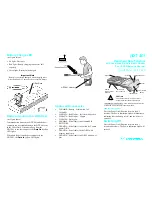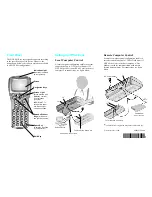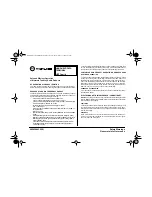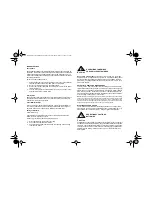
MEDICAL DEVICES
Pacemakers
The Health Industry Manufacturers Association recommends that a minimum
separation of 6 inches (15 centimeters) be maintained between a handheld
wireless radio product and a pacemaker.These recommendations are con-
sistent with the independent research by, and recommendations of, Wireless
Technology Research.
Persons with pacemakers should:
1.
ALWAYS keep the radio product more than six inches (15 centimeters)
from their pacemaker when the radio product is turned ON
.
2.
Not to carry the radio product in the breast pocket.
3.
Use the radio product away from the pacemaker to minimize the poten-
tial for interference.
4.
Turn the radio product OFF immediately if you have any reason to sus-
pect that interference is taking place.
Hearing Aids
Some digital wireless radio products may interfere with some hearing aids. In
the event of such interferences you may want to consult your hearing aid
manufacturer to discuss alternatives.
Other Medical Devices
If you use any other personal medical device, consult the manufacturer of
your device to determine if it is adequately shielded from RF energy.Your
physician may be able to assist you in obtaining this information.
Safety and General
Use While Driving
Check the laws and regulations on the use of radio products in the area
where you drive. Always obey them.
When using your radio product while driving, please:
1.
Give full attention to driving and to the road.
2.
Use hands-free operation, if available.
3.
Pull off the road and park before making or answering a call if driving
conditions so require.
OPERATIONAL WARNINGS
FOR VEHICLES WITH AIR BAG
Do not place a radio prod
uct in the area over an air bag or in the air bag
deployment area. Air bags inflate with great force. If a portable radio product
is placed in the air bag deployment area and the air bag inflates, the radio
product may be propelled with great force and cause serious injury to occu-
pants of the vehicle.
POTENTIALLY EXPLOSIVE ATMOSPHERES
Turn off your two way radio product prior to entering any area with a poten-
tially explosive atmosphere, unless it is a radio product type especially qual-
ified for use in such areas as “Intrinsically Safe” (for example, Factory Mutual,
CSA, or UL Approved). Do not remove, install, or charge batteries in such
areas. Sparks in a potentially explosive atmosphere can cause an explosion
or fire resulting in bodily injury or even death.
NOTE:
The areas with potentially explosive atmospheres referred to above include fueling
areas such as; below decks on boats, fuel or chemical transfer or storage facilities, areas
where the air contains chemicals or particles such as grain, dust, or metal powders;and
any other area where you would normally be advised to turn off your vehicle engine. Areas
with potentially explosive atmospheres are often but not always posted.
BLASTING CAPS AND AREAS
To avoid possible interference with blasting operations, turn off your radio
product when you are near electrical blasting caps, in a "blasting area", or in
areas posted: "turn off two-way radio." Obey all signs and instructions.
All batteries can cause property damage and/or bodily injury such as burns if
a conductive material such as jewelry, keys, or beaded chains touch exposed
terminals. The conductive material may complete an electrical circuit (short
circuit) and become quite hot. Exercise care in handling any charged battery,
particularly when placing it inside a pocket, purse, or other container with
metal objects.
!
C a u t i o n
OPERATIONAL CAUTIONS
BATTERIES
!
W A R N I N G
!
EME Warnings A5 landscapeHTD400 Page 2 Wednesday, October 11, 2000 5:33 PM

